Taxation Law: CGT Asset, Capital Gain and Fringe Benefit
VerifiedAdded on 2023/06/04
|13
|3550
|340
AI Summary
This article discusses the concept of CGT asset, capital gain and fringe benefit in taxation law. It covers various scenarios such as selling of land, antique bed, painting, shares and personal use asset like violin. It also explains the effects of fringe benefit for the individual mentioned in FBTAA 1986.
Contribute Materials
Your contribution can guide someone’s learning journey. Share your
documents today.
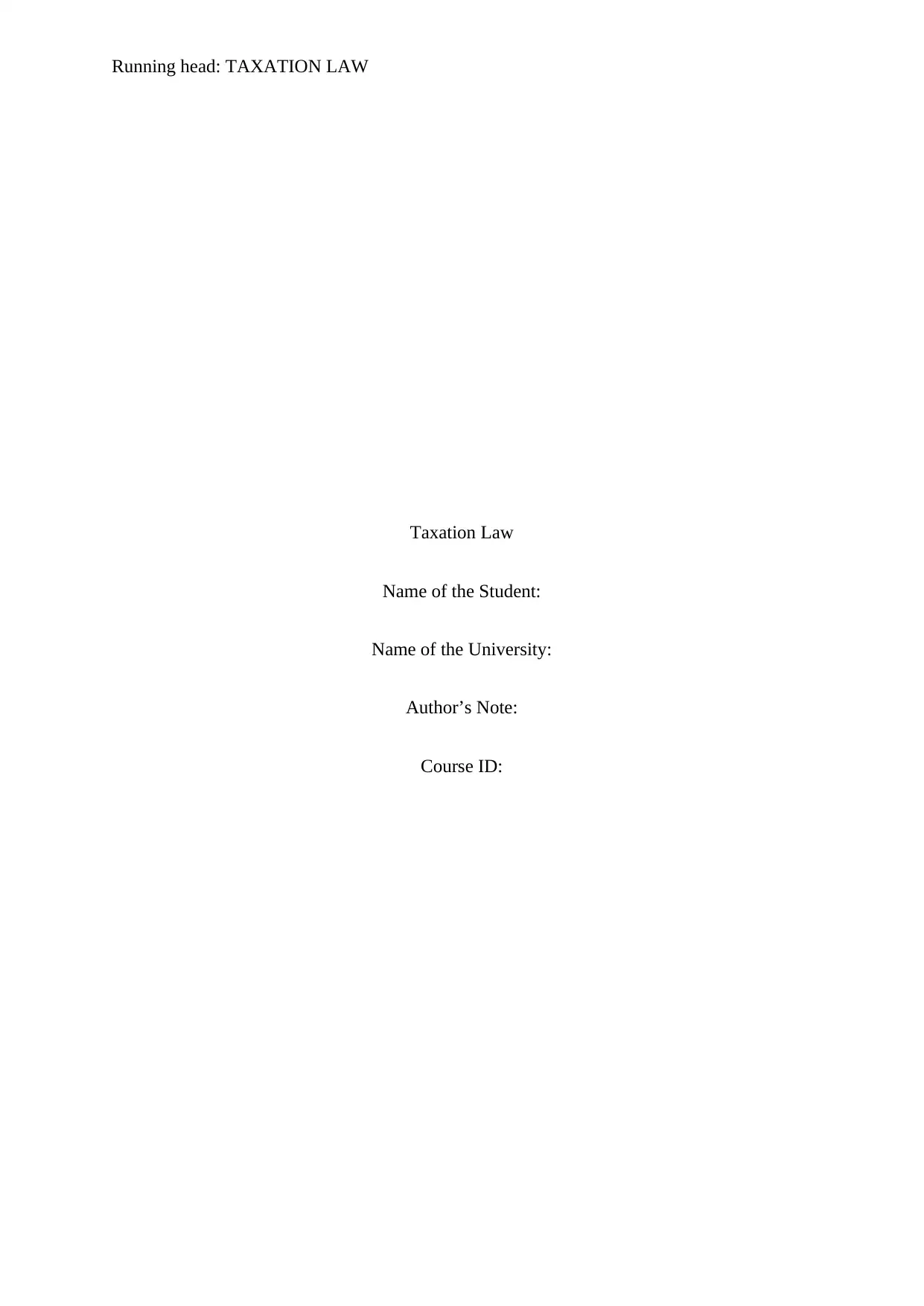
Running head: TAXATION LAW
Taxation Law
Name of the Student:
Name of the University:
Author’s Note:
Course ID:
Taxation Law
Name of the Student:
Name of the University:
Author’s Note:
Course ID:
Secure Best Marks with AI Grader
Need help grading? Try our AI Grader for instant feedback on your assignments.
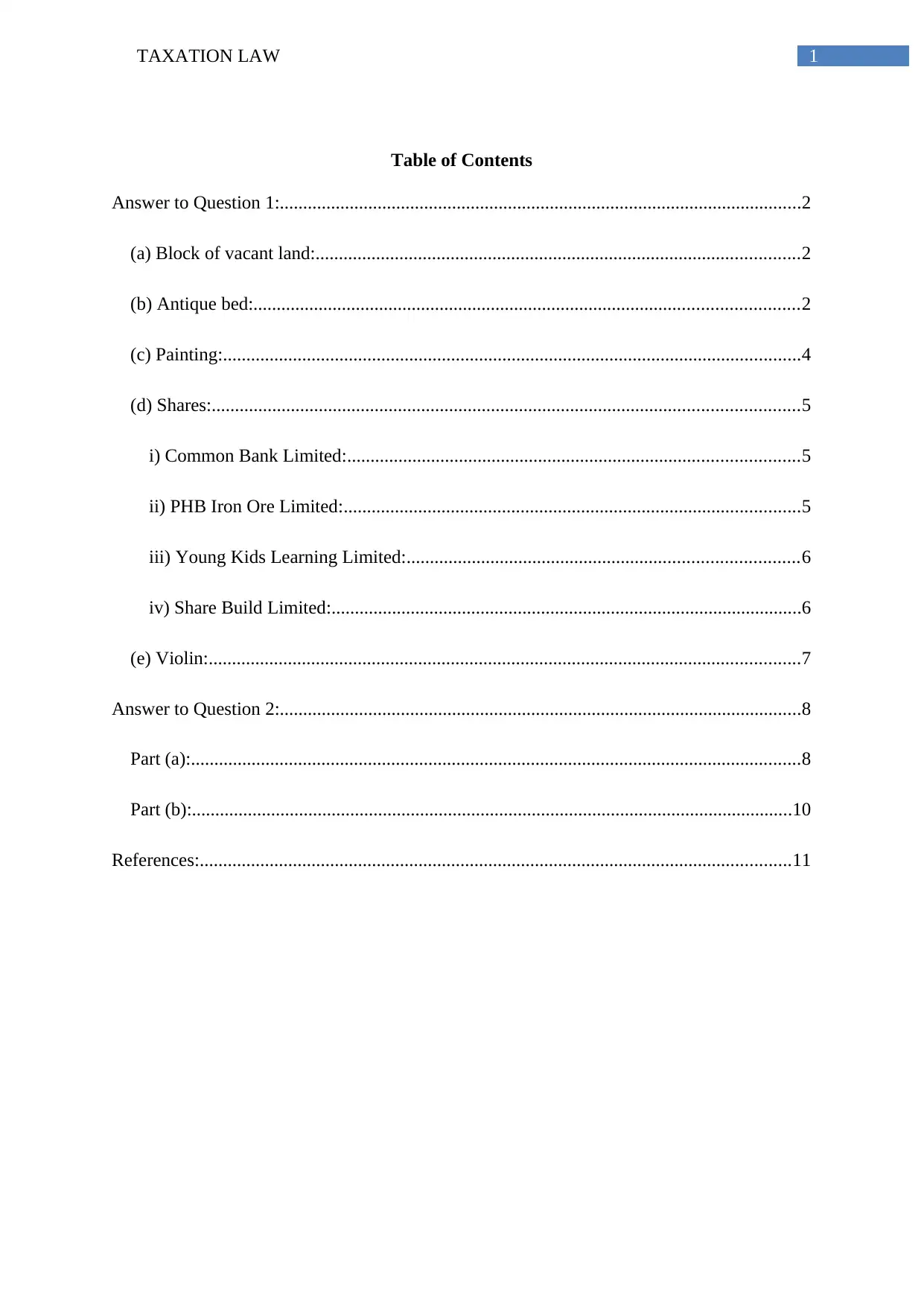
1TAXATION LAW
Table of Contents
Answer to Question 1:................................................................................................................2
(a) Block of vacant land:........................................................................................................2
(b) Antique bed:.....................................................................................................................2
(c) Painting:............................................................................................................................4
(d) Shares:..............................................................................................................................5
i) Common Bank Limited:.................................................................................................5
ii) PHB Iron Ore Limited:..................................................................................................5
iii) Young Kids Learning Limited:....................................................................................6
iv) Share Build Limited:.....................................................................................................6
(e) Violin:...............................................................................................................................7
Answer to Question 2:................................................................................................................8
Part (a):...................................................................................................................................8
Part (b):.................................................................................................................................10
References:...............................................................................................................................11
Table of Contents
Answer to Question 1:................................................................................................................2
(a) Block of vacant land:........................................................................................................2
(b) Antique bed:.....................................................................................................................2
(c) Painting:............................................................................................................................4
(d) Shares:..............................................................................................................................5
i) Common Bank Limited:.................................................................................................5
ii) PHB Iron Ore Limited:..................................................................................................5
iii) Young Kids Learning Limited:....................................................................................6
iv) Share Build Limited:.....................................................................................................6
(e) Violin:...............................................................................................................................7
Answer to Question 2:................................................................................................................8
Part (a):...................................................................................................................................8
Part (b):.................................................................................................................................10
References:...............................................................................................................................11

2TAXATION LAW
Answer to Question 1:
(a) Block of vacant land:
The selling of land could be adjudged as CGT event and in accordance with “Section
108-5 of ITAA 1997”; the land could be termed as CGT asset. When this is the case, the land
sale triggers the event A1, which takes place at the time of signing the contract on 3rd June of
the current tax year, which complies with “Section 104-10 of ITAA 1997”. The capital
proceeds from this sale include $320,000 and the fact that $20,000 is payable on 3rd January
of the next year is not relevant in this case. The overall cost base is obtained as $120,000,
which is computed by adding all the amounts together mentioned as follows:
According to “Section 110-25(2) of ITAA 1997”, acquisition is identified as the first
component of the asset base, which is $100,000 (Barkoczy 2016).
In accordance with “Section 110-25(4) of ITAA 1997”, rates and land taxes are
identified as the third component of the asset base amounting to $20,000, since the
acquisition of land was made after 20th August 1991.
This implies the existence of capital gain due to the fact that overall cost base has not
been more compared to the capital proceeds. Therefore, the capital gain would be $200,000
($320,000 - $120,000). This amount is deemed to be an eligible discount capital gain
mentioned under “Section 115-25(1) of ITAA 1997” (Braithwaite 2017).
(b) Antique bed:
According to the provided information, the antique bed is stolen and this is considered
as CGT asset. According to “Section 104-20(1) of ITAA 1997”, this incident triggers the
event C1. This incident has occurred at the time of obtaining compensation proceeds from the
insurance firm. The issue here is to evaluate whether the antique bed would be collectible.
Answer to Question 1:
(a) Block of vacant land:
The selling of land could be adjudged as CGT event and in accordance with “Section
108-5 of ITAA 1997”; the land could be termed as CGT asset. When this is the case, the land
sale triggers the event A1, which takes place at the time of signing the contract on 3rd June of
the current tax year, which complies with “Section 104-10 of ITAA 1997”. The capital
proceeds from this sale include $320,000 and the fact that $20,000 is payable on 3rd January
of the next year is not relevant in this case. The overall cost base is obtained as $120,000,
which is computed by adding all the amounts together mentioned as follows:
According to “Section 110-25(2) of ITAA 1997”, acquisition is identified as the first
component of the asset base, which is $100,000 (Barkoczy 2016).
In accordance with “Section 110-25(4) of ITAA 1997”, rates and land taxes are
identified as the third component of the asset base amounting to $20,000, since the
acquisition of land was made after 20th August 1991.
This implies the existence of capital gain due to the fact that overall cost base has not
been more compared to the capital proceeds. Therefore, the capital gain would be $200,000
($320,000 - $120,000). This amount is deemed to be an eligible discount capital gain
mentioned under “Section 115-25(1) of ITAA 1997” (Braithwaite 2017).
(b) Antique bed:
According to the provided information, the antique bed is stolen and this is considered
as CGT asset. According to “Section 104-20(1) of ITAA 1997”, this incident triggers the
event C1. This incident has occurred at the time of obtaining compensation proceeds from the
insurance firm. The issue here is to evaluate whether the antique bed would be collectible.
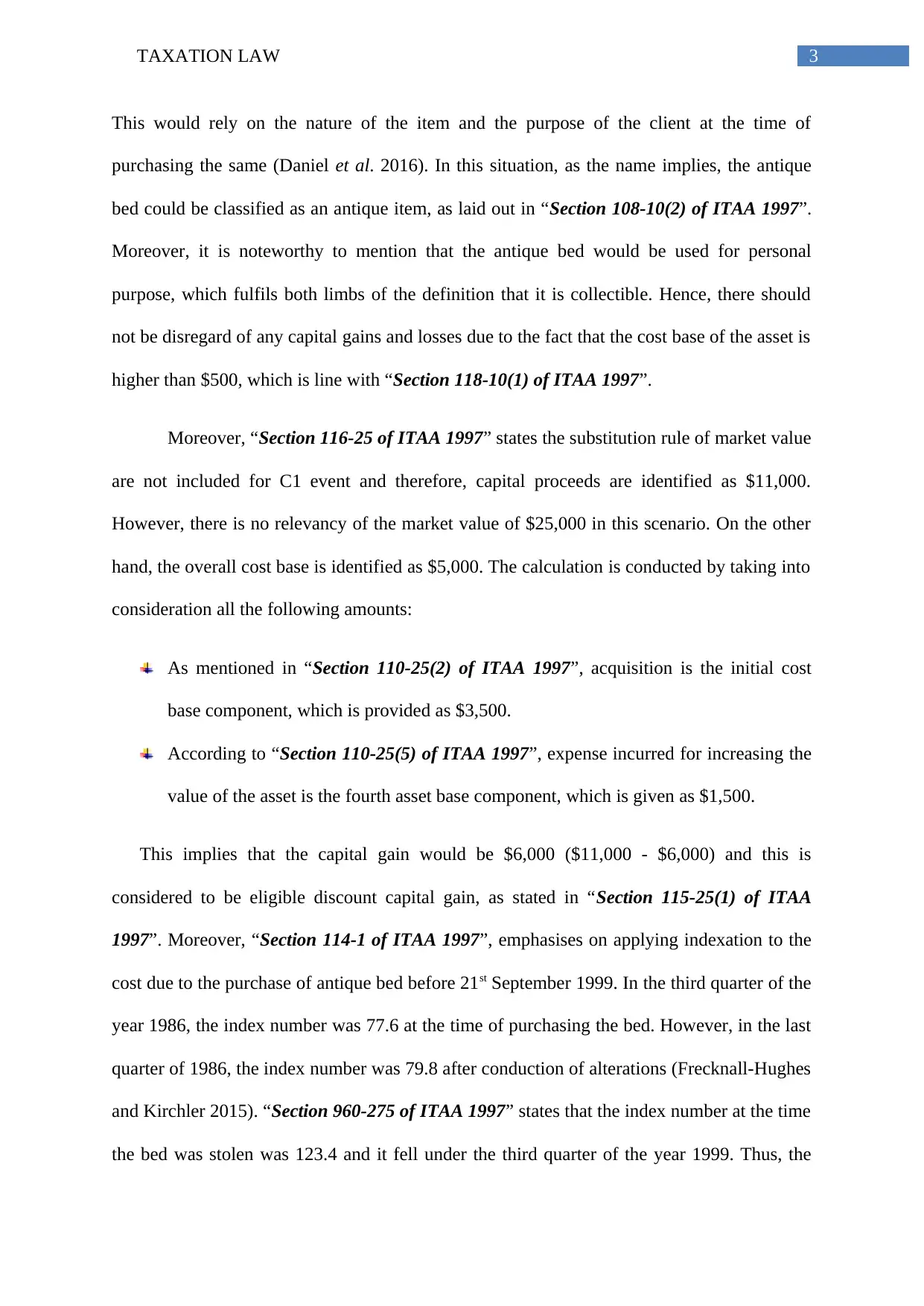
3TAXATION LAW
This would rely on the nature of the item and the purpose of the client at the time of
purchasing the same (Daniel et al. 2016). In this situation, as the name implies, the antique
bed could be classified as an antique item, as laid out in “Section 108-10(2) of ITAA 1997”.
Moreover, it is noteworthy to mention that the antique bed would be used for personal
purpose, which fulfils both limbs of the definition that it is collectible. Hence, there should
not be disregard of any capital gains and losses due to the fact that the cost base of the asset is
higher than $500, which is line with “Section 118-10(1) of ITAA 1997”.
Moreover, “Section 116-25 of ITAA 1997” states the substitution rule of market value
are not included for C1 event and therefore, capital proceeds are identified as $11,000.
However, there is no relevancy of the market value of $25,000 in this scenario. On the other
hand, the overall cost base is identified as $5,000. The calculation is conducted by taking into
consideration all the following amounts:
As mentioned in “Section 110-25(2) of ITAA 1997”, acquisition is the initial cost
base component, which is provided as $3,500.
According to “Section 110-25(5) of ITAA 1997”, expense incurred for increasing the
value of the asset is the fourth asset base component, which is given as $1,500.
This implies that the capital gain would be $6,000 ($11,000 - $6,000) and this is
considered to be eligible discount capital gain, as stated in “Section 115-25(1) of ITAA
1997”. Moreover, “Section 114-1 of ITAA 1997”, emphasises on applying indexation to the
cost due to the purchase of antique bed before 21st September 1999. In the third quarter of the
year 1986, the index number was 77.6 at the time of purchasing the bed. However, in the last
quarter of 1986, the index number was 79.8 after conduction of alterations (Frecknall-Hughes
and Kirchler 2015). “Section 960-275 of ITAA 1997” states that the index number at the time
the bed was stolen was 123.4 and it fell under the third quarter of the year 1999. Thus, the
This would rely on the nature of the item and the purpose of the client at the time of
purchasing the same (Daniel et al. 2016). In this situation, as the name implies, the antique
bed could be classified as an antique item, as laid out in “Section 108-10(2) of ITAA 1997”.
Moreover, it is noteworthy to mention that the antique bed would be used for personal
purpose, which fulfils both limbs of the definition that it is collectible. Hence, there should
not be disregard of any capital gains and losses due to the fact that the cost base of the asset is
higher than $500, which is line with “Section 118-10(1) of ITAA 1997”.
Moreover, “Section 116-25 of ITAA 1997” states the substitution rule of market value
are not included for C1 event and therefore, capital proceeds are identified as $11,000.
However, there is no relevancy of the market value of $25,000 in this scenario. On the other
hand, the overall cost base is identified as $5,000. The calculation is conducted by taking into
consideration all the following amounts:
As mentioned in “Section 110-25(2) of ITAA 1997”, acquisition is the initial cost
base component, which is provided as $3,500.
According to “Section 110-25(5) of ITAA 1997”, expense incurred for increasing the
value of the asset is the fourth asset base component, which is given as $1,500.
This implies that the capital gain would be $6,000 ($11,000 - $6,000) and this is
considered to be eligible discount capital gain, as stated in “Section 115-25(1) of ITAA
1997”. Moreover, “Section 114-1 of ITAA 1997”, emphasises on applying indexation to the
cost due to the purchase of antique bed before 21st September 1999. In the third quarter of the
year 1986, the index number was 77.6 at the time of purchasing the bed. However, in the last
quarter of 1986, the index number was 79.8 after conduction of alterations (Frecknall-Hughes
and Kirchler 2015). “Section 960-275 of ITAA 1997” states that the index number at the time
the bed was stolen was 123.4 and it fell under the third quarter of the year 1999. Thus, the
Paraphrase This Document
Need a fresh take? Get an instant paraphrase of this document with our AI Paraphraser
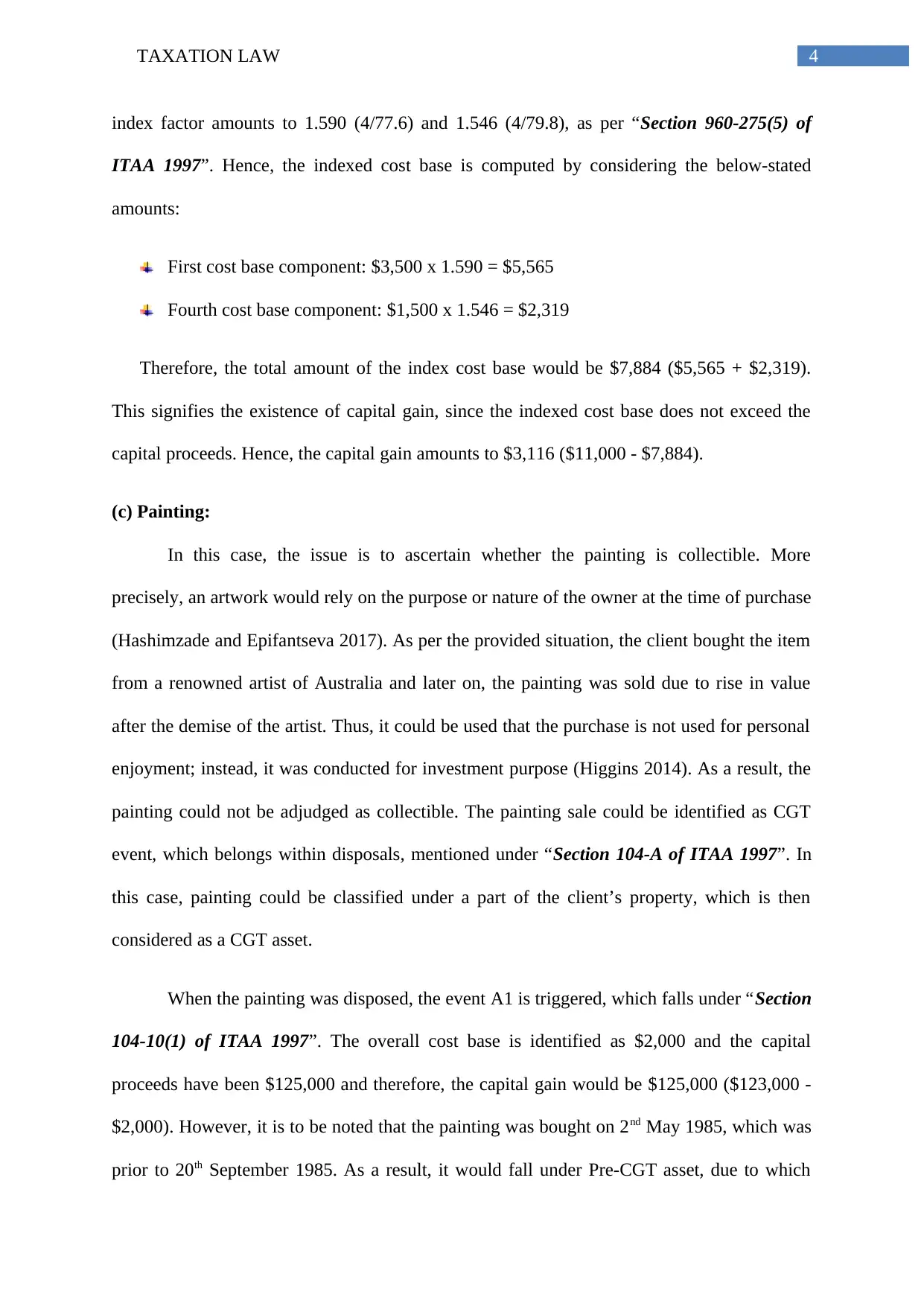
4TAXATION LAW
index factor amounts to 1.590 (4/77.6) and 1.546 (4/79.8), as per “Section 960-275(5) of
ITAA 1997”. Hence, the indexed cost base is computed by considering the below-stated
amounts:
First cost base component: $3,500 x 1.590 = $5,565
Fourth cost base component: $1,500 x 1.546 = $2,319
Therefore, the total amount of the index cost base would be $7,884 ($5,565 + $2,319).
This signifies the existence of capital gain, since the indexed cost base does not exceed the
capital proceeds. Hence, the capital gain amounts to $3,116 ($11,000 - $7,884).
(c) Painting:
In this case, the issue is to ascertain whether the painting is collectible. More
precisely, an artwork would rely on the purpose or nature of the owner at the time of purchase
(Hashimzade and Epifantseva 2017). As per the provided situation, the client bought the item
from a renowned artist of Australia and later on, the painting was sold due to rise in value
after the demise of the artist. Thus, it could be used that the purchase is not used for personal
enjoyment; instead, it was conducted for investment purpose (Higgins 2014). As a result, the
painting could not be adjudged as collectible. The painting sale could be identified as CGT
event, which belongs within disposals, mentioned under “Section 104-A of ITAA 1997”. In
this case, painting could be classified under a part of the client’s property, which is then
considered as a CGT asset.
When the painting was disposed, the event A1 is triggered, which falls under “Section
104-10(1) of ITAA 1997”. The overall cost base is identified as $2,000 and the capital
proceeds have been $125,000 and therefore, the capital gain would be $125,000 ($123,000 -
$2,000). However, it is to be noted that the painting was bought on 2nd May 1985, which was
prior to 20th September 1985. As a result, it would fall under Pre-CGT asset, due to which
index factor amounts to 1.590 (4/77.6) and 1.546 (4/79.8), as per “Section 960-275(5) of
ITAA 1997”. Hence, the indexed cost base is computed by considering the below-stated
amounts:
First cost base component: $3,500 x 1.590 = $5,565
Fourth cost base component: $1,500 x 1.546 = $2,319
Therefore, the total amount of the index cost base would be $7,884 ($5,565 + $2,319).
This signifies the existence of capital gain, since the indexed cost base does not exceed the
capital proceeds. Hence, the capital gain amounts to $3,116 ($11,000 - $7,884).
(c) Painting:
In this case, the issue is to ascertain whether the painting is collectible. More
precisely, an artwork would rely on the purpose or nature of the owner at the time of purchase
(Hashimzade and Epifantseva 2017). As per the provided situation, the client bought the item
from a renowned artist of Australia and later on, the painting was sold due to rise in value
after the demise of the artist. Thus, it could be used that the purchase is not used for personal
enjoyment; instead, it was conducted for investment purpose (Higgins 2014). As a result, the
painting could not be adjudged as collectible. The painting sale could be identified as CGT
event, which belongs within disposals, mentioned under “Section 104-A of ITAA 1997”. In
this case, painting could be classified under a part of the client’s property, which is then
considered as a CGT asset.
When the painting was disposed, the event A1 is triggered, which falls under “Section
104-10(1) of ITAA 1997”. The overall cost base is identified as $2,000 and the capital
proceeds have been $125,000 and therefore, the capital gain would be $125,000 ($123,000 -
$2,000). However, it is to be noted that the painting was bought on 2nd May 1985, which was
prior to 20th September 1985. As a result, it would fall under Pre-CGT asset, due to which

5TAXATION LAW
capital gain would be disregarded, in accordance with “Section 104-10(5) of ITAA 1997”
(Littlewood and Elliffe 2017).
(d) Shares:
i) Common Bank Limited:
Since share in an organisation is a CGT asset, as per “Section 108-5 of ITAA 1997”, the
selling of shares would lead to ownership change of shares. This would trigger A1 event in
compliance with “Section 104-10(1) of ITAA 1997”. This change is evident, after the sale of
shares on 4th July. Moreover, indexation is not applicable to the cost base, as the shares were
bought after 21st September 1999 (McGregor-Lowndes 2016). In this situation, the capital
proceeds denote the money received by or entitled to the taxpayer in relation to the event
occurrence, which are obtained as $47,000 ($47 x 1,000). On the other hand, the overall cost
base is obtained as $16.300 by taking into consideration the following amounts:
As per “Section 110-25(2) of ITAA 1997”, acquisition cost is the initial cost base
component, which is $15,000 ($15 x 1,000).
“Section 110-35 of ITAA 1997” cites that brokerage fees are the second cost base
component, which is $550.
Another component of the cost base is stamp duty cost, which is $750, as per the
above section.
Hence, the capital gain of the client would be $30,700 and this is considered as eligible
discount capital gain, as per “Section 115-25(1) of ITAA 1997”.
ii) PHB Iron Ore Limited:
The case is similar to that of Common Bank Limited, in which the ownership has
changed after selling the shares on 14th February. The capital proceeds have been $62,500
capital gain would be disregarded, in accordance with “Section 104-10(5) of ITAA 1997”
(Littlewood and Elliffe 2017).
(d) Shares:
i) Common Bank Limited:
Since share in an organisation is a CGT asset, as per “Section 108-5 of ITAA 1997”, the
selling of shares would lead to ownership change of shares. This would trigger A1 event in
compliance with “Section 104-10(1) of ITAA 1997”. This change is evident, after the sale of
shares on 4th July. Moreover, indexation is not applicable to the cost base, as the shares were
bought after 21st September 1999 (McGregor-Lowndes 2016). In this situation, the capital
proceeds denote the money received by or entitled to the taxpayer in relation to the event
occurrence, which are obtained as $47,000 ($47 x 1,000). On the other hand, the overall cost
base is obtained as $16.300 by taking into consideration the following amounts:
As per “Section 110-25(2) of ITAA 1997”, acquisition cost is the initial cost base
component, which is $15,000 ($15 x 1,000).
“Section 110-35 of ITAA 1997” cites that brokerage fees are the second cost base
component, which is $550.
Another component of the cost base is stamp duty cost, which is $750, as per the
above section.
Hence, the capital gain of the client would be $30,700 and this is considered as eligible
discount capital gain, as per “Section 115-25(1) of ITAA 1997”.
ii) PHB Iron Ore Limited:
The case is similar to that of Common Bank Limited, in which the ownership has
changed after selling the shares on 14th February. The capital proceeds have been $62,500
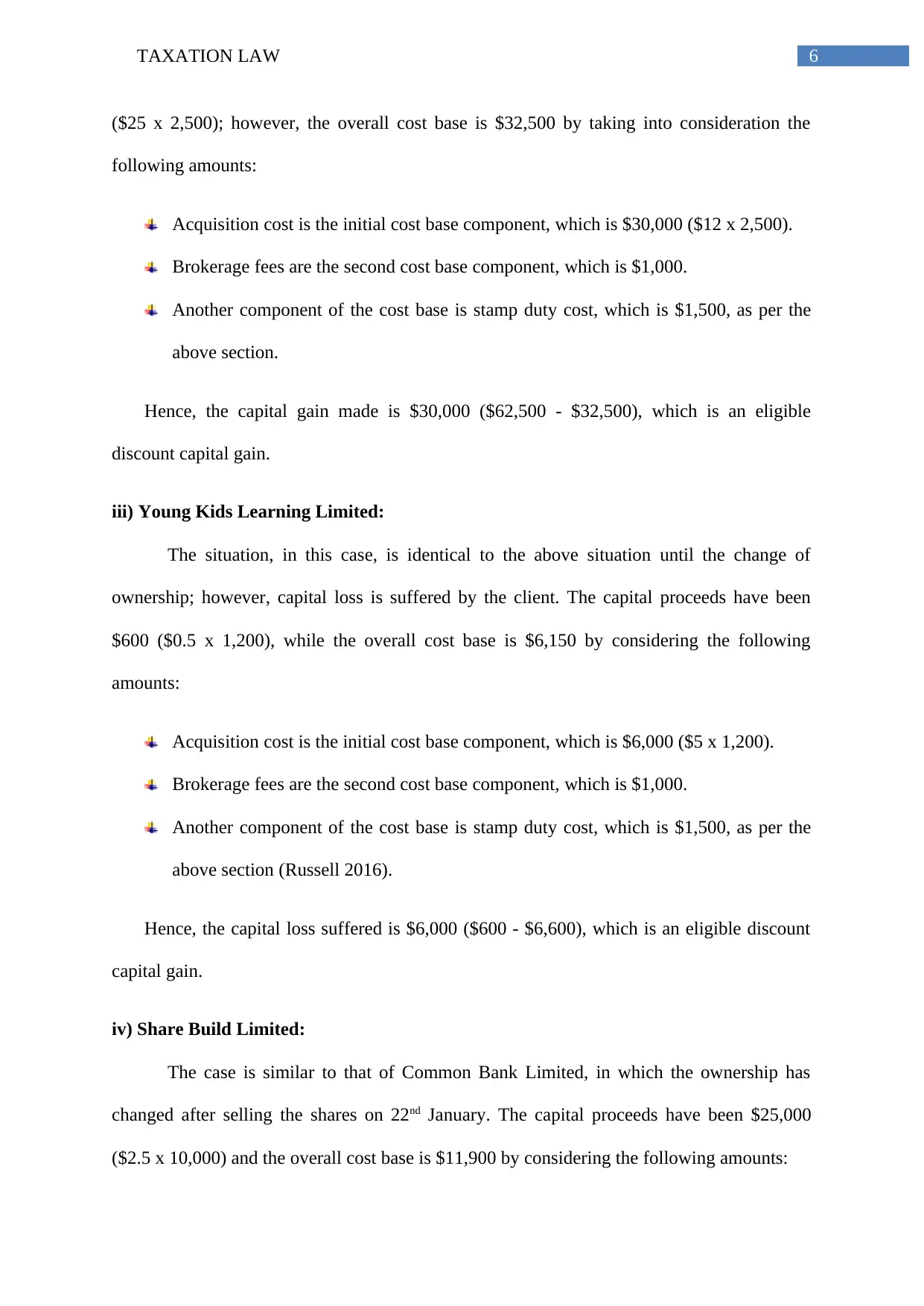
6TAXATION LAW
($25 x 2,500); however, the overall cost base is $32,500 by taking into consideration the
following amounts:
Acquisition cost is the initial cost base component, which is $30,000 ($12 x 2,500).
Brokerage fees are the second cost base component, which is $1,000.
Another component of the cost base is stamp duty cost, which is $1,500, as per the
above section.
Hence, the capital gain made is $30,000 ($62,500 - $32,500), which is an eligible
discount capital gain.
iii) Young Kids Learning Limited:
The situation, in this case, is identical to the above situation until the change of
ownership; however, capital loss is suffered by the client. The capital proceeds have been
$600 ($0.5 x 1,200), while the overall cost base is $6,150 by considering the following
amounts:
Acquisition cost is the initial cost base component, which is $6,000 ($5 x 1,200).
Brokerage fees are the second cost base component, which is $1,000.
Another component of the cost base is stamp duty cost, which is $1,500, as per the
above section (Russell 2016).
Hence, the capital loss suffered is $6,000 ($600 - $6,600), which is an eligible discount
capital gain.
iv) Share Build Limited:
The case is similar to that of Common Bank Limited, in which the ownership has
changed after selling the shares on 22nd January. The capital proceeds have been $25,000
($2.5 x 10,000) and the overall cost base is $11,900 by considering the following amounts:
($25 x 2,500); however, the overall cost base is $32,500 by taking into consideration the
following amounts:
Acquisition cost is the initial cost base component, which is $30,000 ($12 x 2,500).
Brokerage fees are the second cost base component, which is $1,000.
Another component of the cost base is stamp duty cost, which is $1,500, as per the
above section.
Hence, the capital gain made is $30,000 ($62,500 - $32,500), which is an eligible
discount capital gain.
iii) Young Kids Learning Limited:
The situation, in this case, is identical to the above situation until the change of
ownership; however, capital loss is suffered by the client. The capital proceeds have been
$600 ($0.5 x 1,200), while the overall cost base is $6,150 by considering the following
amounts:
Acquisition cost is the initial cost base component, which is $6,000 ($5 x 1,200).
Brokerage fees are the second cost base component, which is $1,000.
Another component of the cost base is stamp duty cost, which is $1,500, as per the
above section (Russell 2016).
Hence, the capital loss suffered is $6,000 ($600 - $6,600), which is an eligible discount
capital gain.
iv) Share Build Limited:
The case is similar to that of Common Bank Limited, in which the ownership has
changed after selling the shares on 22nd January. The capital proceeds have been $25,000
($2.5 x 10,000) and the overall cost base is $11,900 by considering the following amounts:
Secure Best Marks with AI Grader
Need help grading? Try our AI Grader for instant feedback on your assignments.
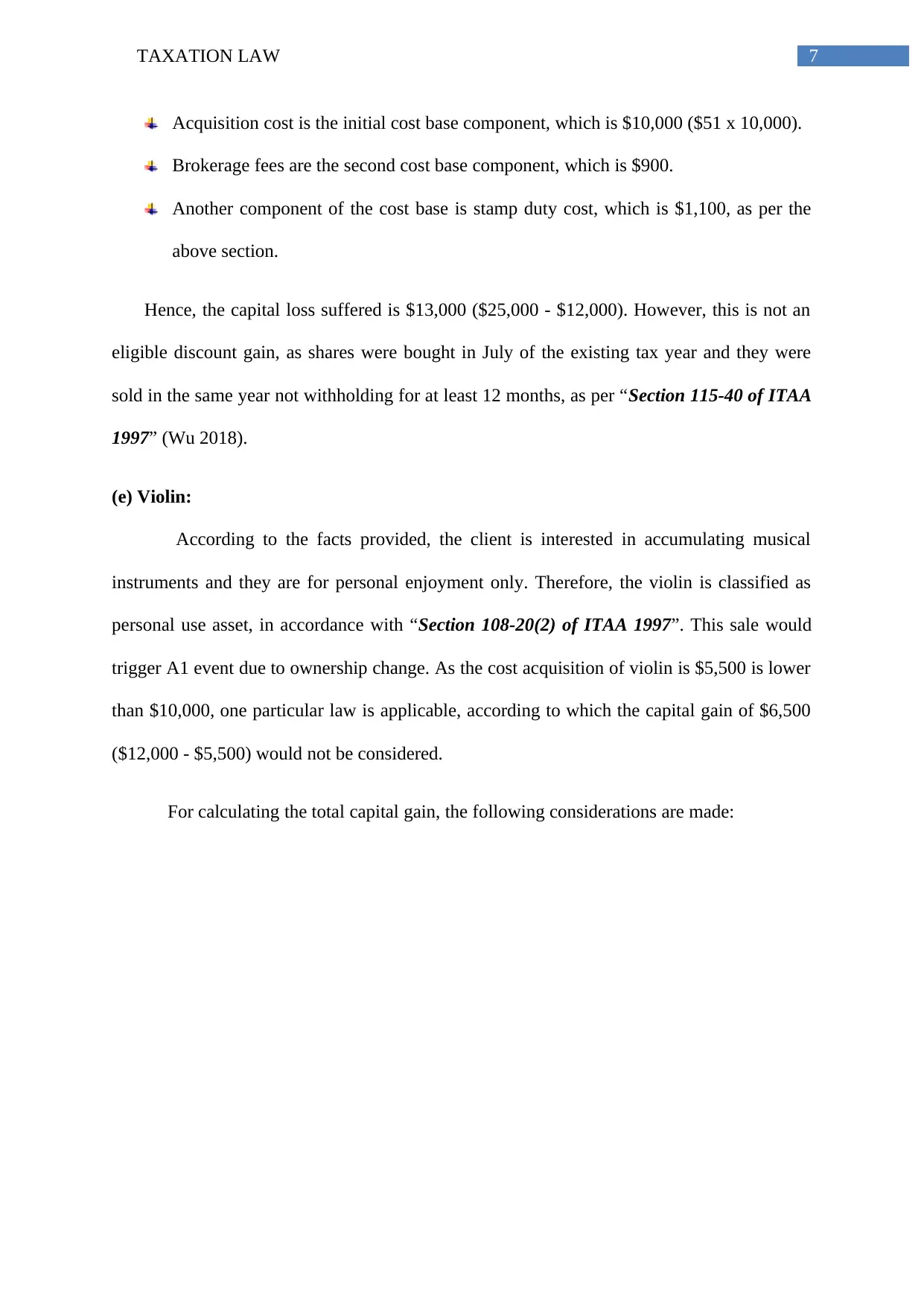
7TAXATION LAW
Acquisition cost is the initial cost base component, which is $10,000 ($51 x 10,000).
Brokerage fees are the second cost base component, which is $900.
Another component of the cost base is stamp duty cost, which is $1,100, as per the
above section.
Hence, the capital loss suffered is $13,000 ($25,000 - $12,000). However, this is not an
eligible discount gain, as shares were bought in July of the existing tax year and they were
sold in the same year not withholding for at least 12 months, as per “Section 115-40 of ITAA
1997” (Wu 2018).
(e) Violin:
According to the facts provided, the client is interested in accumulating musical
instruments and they are for personal enjoyment only. Therefore, the violin is classified as
personal use asset, in accordance with “Section 108-20(2) of ITAA 1997”. This sale would
trigger A1 event due to ownership change. As the cost acquisition of violin is $5,500 is lower
than $10,000, one particular law is applicable, according to which the capital gain of $6,500
($12,000 - $5,500) would not be considered.
For calculating the total capital gain, the following considerations are made:
Acquisition cost is the initial cost base component, which is $10,000 ($51 x 10,000).
Brokerage fees are the second cost base component, which is $900.
Another component of the cost base is stamp duty cost, which is $1,100, as per the
above section.
Hence, the capital loss suffered is $13,000 ($25,000 - $12,000). However, this is not an
eligible discount gain, as shares were bought in July of the existing tax year and they were
sold in the same year not withholding for at least 12 months, as per “Section 115-40 of ITAA
1997” (Wu 2018).
(e) Violin:
According to the facts provided, the client is interested in accumulating musical
instruments and they are for personal enjoyment only. Therefore, the violin is classified as
personal use asset, in accordance with “Section 108-20(2) of ITAA 1997”. This sale would
trigger A1 event due to ownership change. As the cost acquisition of violin is $5,500 is lower
than $10,000, one particular law is applicable, according to which the capital gain of $6,500
($12,000 - $5,500) would not be considered.
For calculating the total capital gain, the following considerations are made:
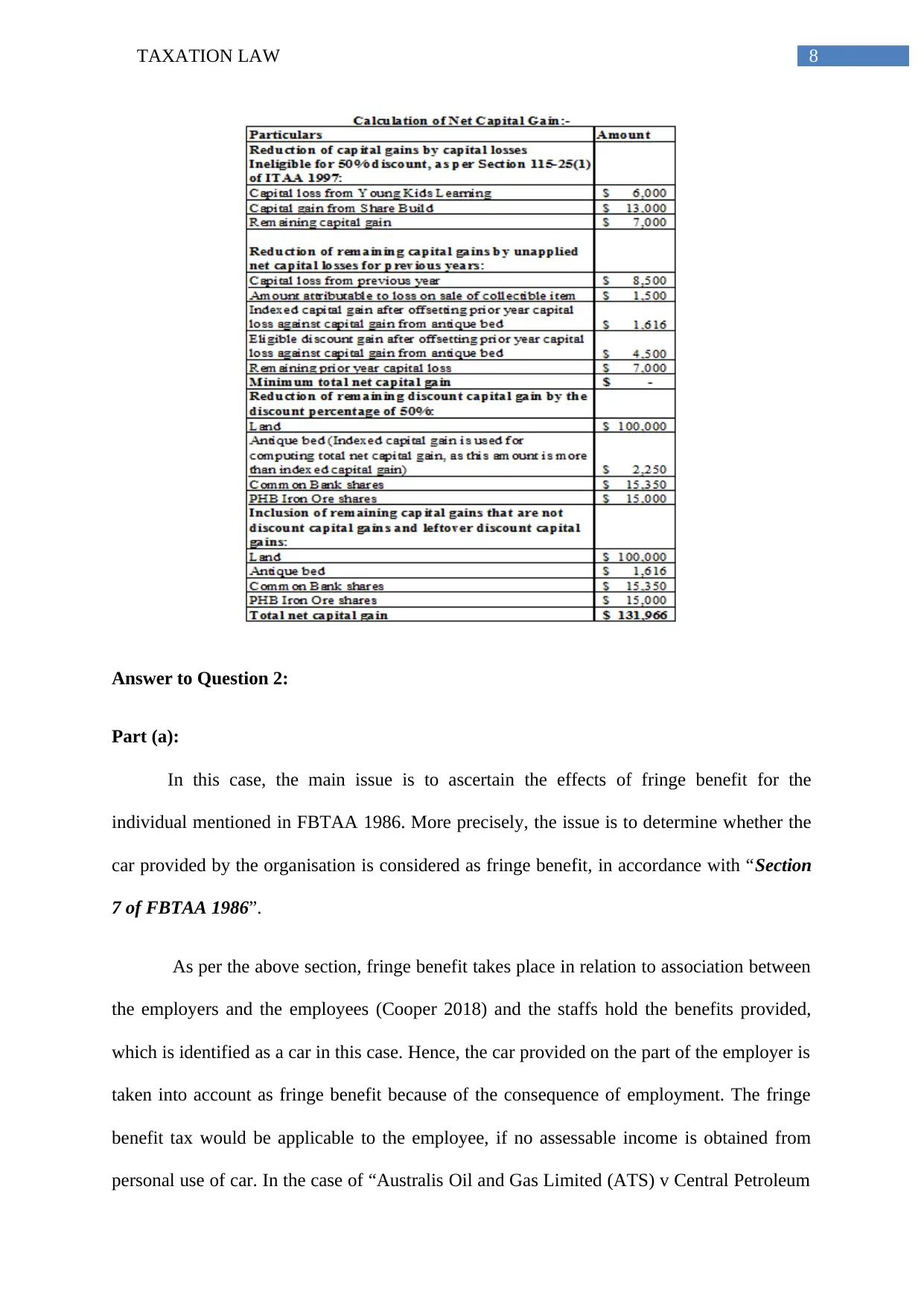
8TAXATION LAW
Answer to Question 2:
Part (a):
In this case, the main issue is to ascertain the effects of fringe benefit for the
individual mentioned in FBTAA 1986. More precisely, the issue is to determine whether the
car provided by the organisation is considered as fringe benefit, in accordance with “Section
7 of FBTAA 1986”.
As per the above section, fringe benefit takes place in relation to association between
the employers and the employees (Cooper 2018) and the staffs hold the benefits provided,
which is identified as a car in this case. Hence, the car provided on the part of the employer is
taken into account as fringe benefit because of the consequence of employment. The fringe
benefit tax would be applicable to the employee, if no assessable income is obtained from
personal use of car. In the case of “Australis Oil and Gas Limited (ATS) v Central Petroleum
Answer to Question 2:
Part (a):
In this case, the main issue is to ascertain the effects of fringe benefit for the
individual mentioned in FBTAA 1986. More precisely, the issue is to determine whether the
car provided by the organisation is considered as fringe benefit, in accordance with “Section
7 of FBTAA 1986”.
As per the above section, fringe benefit takes place in relation to association between
the employers and the employees (Cooper 2018) and the staffs hold the benefits provided,
which is identified as a car in this case. Hence, the car provided on the part of the employer is
taken into account as fringe benefit because of the consequence of employment. The fringe
benefit tax would be applicable to the employee, if no assessable income is obtained from
personal use of car. In the case of “Australis Oil and Gas Limited (ATS) v Central Petroleum
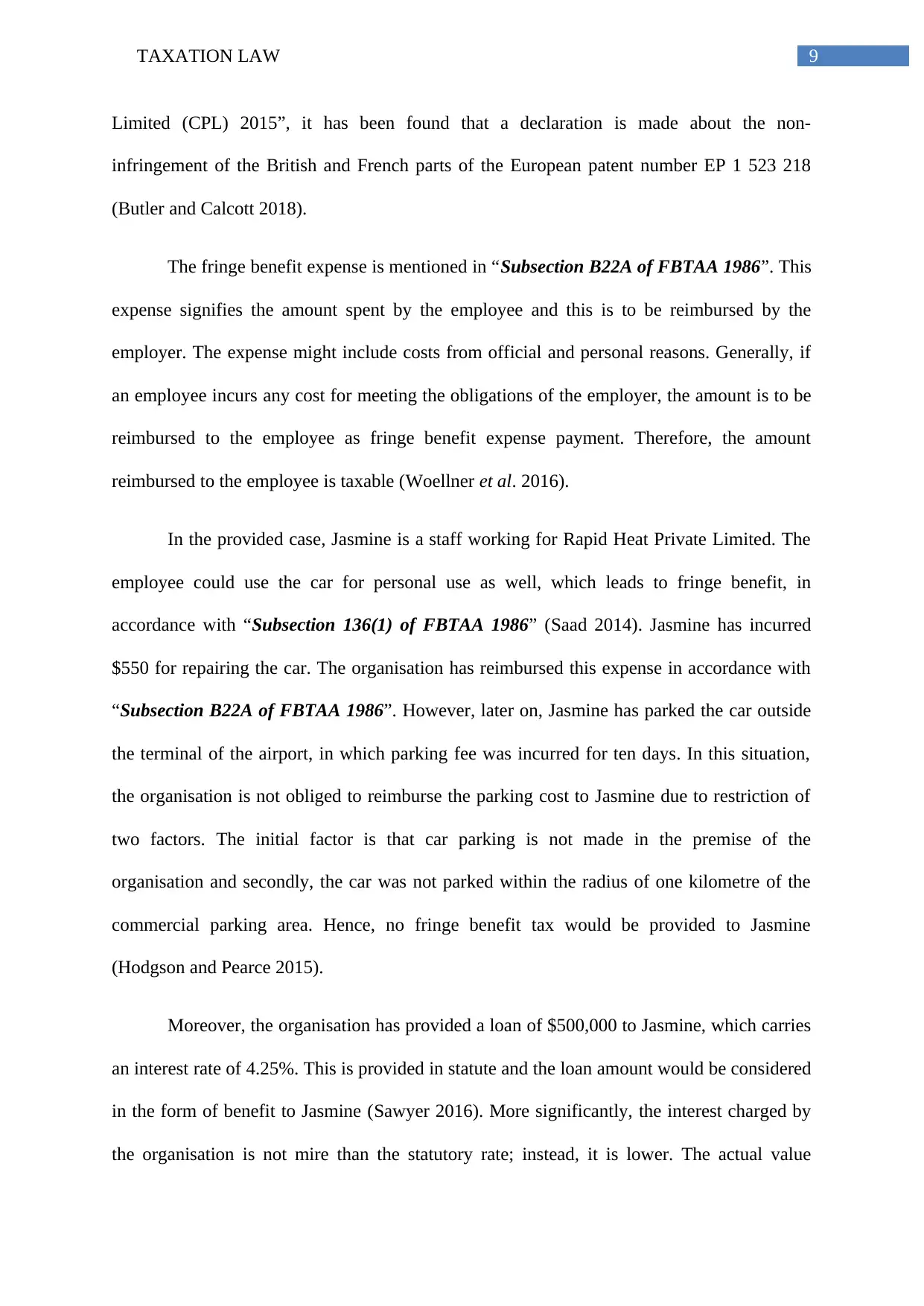
9TAXATION LAW
Limited (CPL) 2015”, it has been found that a declaration is made about the non-
infringement of the British and French parts of the European patent number EP 1 523 218
(Butler and Calcott 2018).
The fringe benefit expense is mentioned in “Subsection B22A of FBTAA 1986”. This
expense signifies the amount spent by the employee and this is to be reimbursed by the
employer. The expense might include costs from official and personal reasons. Generally, if
an employee incurs any cost for meeting the obligations of the employer, the amount is to be
reimbursed to the employee as fringe benefit expense payment. Therefore, the amount
reimbursed to the employee is taxable (Woellner et al. 2016).
In the provided case, Jasmine is a staff working for Rapid Heat Private Limited. The
employee could use the car for personal use as well, which leads to fringe benefit, in
accordance with “Subsection 136(1) of FBTAA 1986” (Saad 2014). Jasmine has incurred
$550 for repairing the car. The organisation has reimbursed this expense in accordance with
“Subsection B22A of FBTAA 1986”. However, later on, Jasmine has parked the car outside
the terminal of the airport, in which parking fee was incurred for ten days. In this situation,
the organisation is not obliged to reimburse the parking cost to Jasmine due to restriction of
two factors. The initial factor is that car parking is not made in the premise of the
organisation and secondly, the car was not parked within the radius of one kilometre of the
commercial parking area. Hence, no fringe benefit tax would be provided to Jasmine
(Hodgson and Pearce 2015).
Moreover, the organisation has provided a loan of $500,000 to Jasmine, which carries
an interest rate of 4.25%. This is provided in statute and the loan amount would be considered
in the form of benefit to Jasmine (Sawyer 2016). More significantly, the interest charged by
the organisation is not mire than the statutory rate; instead, it is lower. The actual value
Limited (CPL) 2015”, it has been found that a declaration is made about the non-
infringement of the British and French parts of the European patent number EP 1 523 218
(Butler and Calcott 2018).
The fringe benefit expense is mentioned in “Subsection B22A of FBTAA 1986”. This
expense signifies the amount spent by the employee and this is to be reimbursed by the
employer. The expense might include costs from official and personal reasons. Generally, if
an employee incurs any cost for meeting the obligations of the employer, the amount is to be
reimbursed to the employee as fringe benefit expense payment. Therefore, the amount
reimbursed to the employee is taxable (Woellner et al. 2016).
In the provided case, Jasmine is a staff working for Rapid Heat Private Limited. The
employee could use the car for personal use as well, which leads to fringe benefit, in
accordance with “Subsection 136(1) of FBTAA 1986” (Saad 2014). Jasmine has incurred
$550 for repairing the car. The organisation has reimbursed this expense in accordance with
“Subsection B22A of FBTAA 1986”. However, later on, Jasmine has parked the car outside
the terminal of the airport, in which parking fee was incurred for ten days. In this situation,
the organisation is not obliged to reimburse the parking cost to Jasmine due to restriction of
two factors. The initial factor is that car parking is not made in the premise of the
organisation and secondly, the car was not parked within the radius of one kilometre of the
commercial parking area. Hence, no fringe benefit tax would be provided to Jasmine
(Hodgson and Pearce 2015).
Moreover, the organisation has provided a loan of $500,000 to Jasmine, which carries
an interest rate of 4.25%. This is provided in statute and the loan amount would be considered
in the form of benefit to Jasmine (Sawyer 2016). More significantly, the interest charged by
the organisation is not mire than the statutory rate; instead, it is lower. The actual value
Paraphrase This Document
Need a fresh take? Get an instant paraphrase of this document with our AI Paraphraser
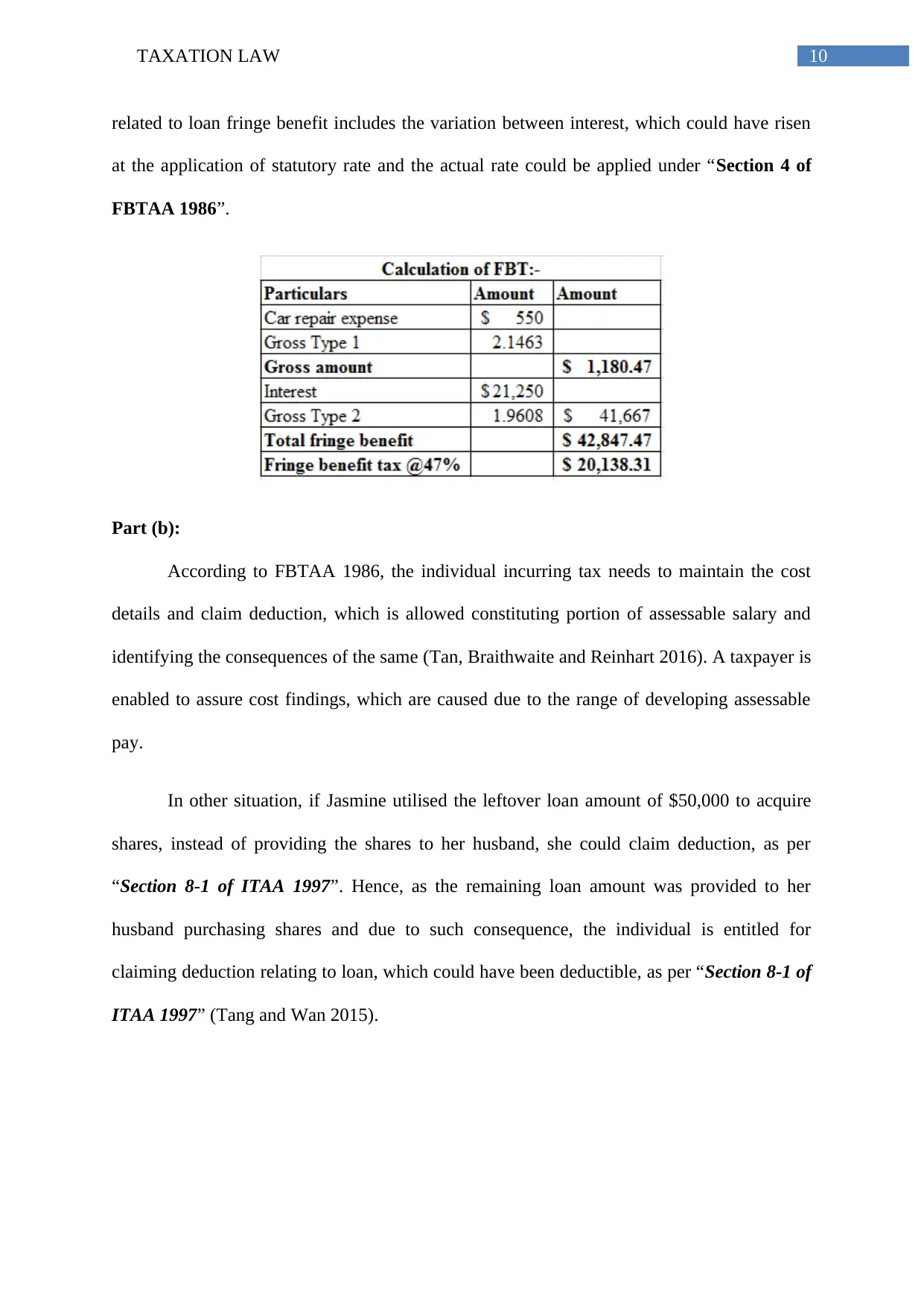
10TAXATION LAW
related to loan fringe benefit includes the variation between interest, which could have risen
at the application of statutory rate and the actual rate could be applied under “Section 4 of
FBTAA 1986”.
Part (b):
According to FBTAA 1986, the individual incurring tax needs to maintain the cost
details and claim deduction, which is allowed constituting portion of assessable salary and
identifying the consequences of the same (Tan, Braithwaite and Reinhart 2016). A taxpayer is
enabled to assure cost findings, which are caused due to the range of developing assessable
pay.
In other situation, if Jasmine utilised the leftover loan amount of $50,000 to acquire
shares, instead of providing the shares to her husband, she could claim deduction, as per
“Section 8-1 of ITAA 1997”. Hence, as the remaining loan amount was provided to her
husband purchasing shares and due to such consequence, the individual is entitled for
claiming deduction relating to loan, which could have been deductible, as per “Section 8-1 of
ITAA 1997” (Tang and Wan 2015).
related to loan fringe benefit includes the variation between interest, which could have risen
at the application of statutory rate and the actual rate could be applied under “Section 4 of
FBTAA 1986”.
Part (b):
According to FBTAA 1986, the individual incurring tax needs to maintain the cost
details and claim deduction, which is allowed constituting portion of assessable salary and
identifying the consequences of the same (Tan, Braithwaite and Reinhart 2016). A taxpayer is
enabled to assure cost findings, which are caused due to the range of developing assessable
pay.
In other situation, if Jasmine utilised the leftover loan amount of $50,000 to acquire
shares, instead of providing the shares to her husband, she could claim deduction, as per
“Section 8-1 of ITAA 1997”. Hence, as the remaining loan amount was provided to her
husband purchasing shares and due to such consequence, the individual is entitled for
claiming deduction relating to loan, which could have been deductible, as per “Section 8-1 of
ITAA 1997” (Tang and Wan 2015).
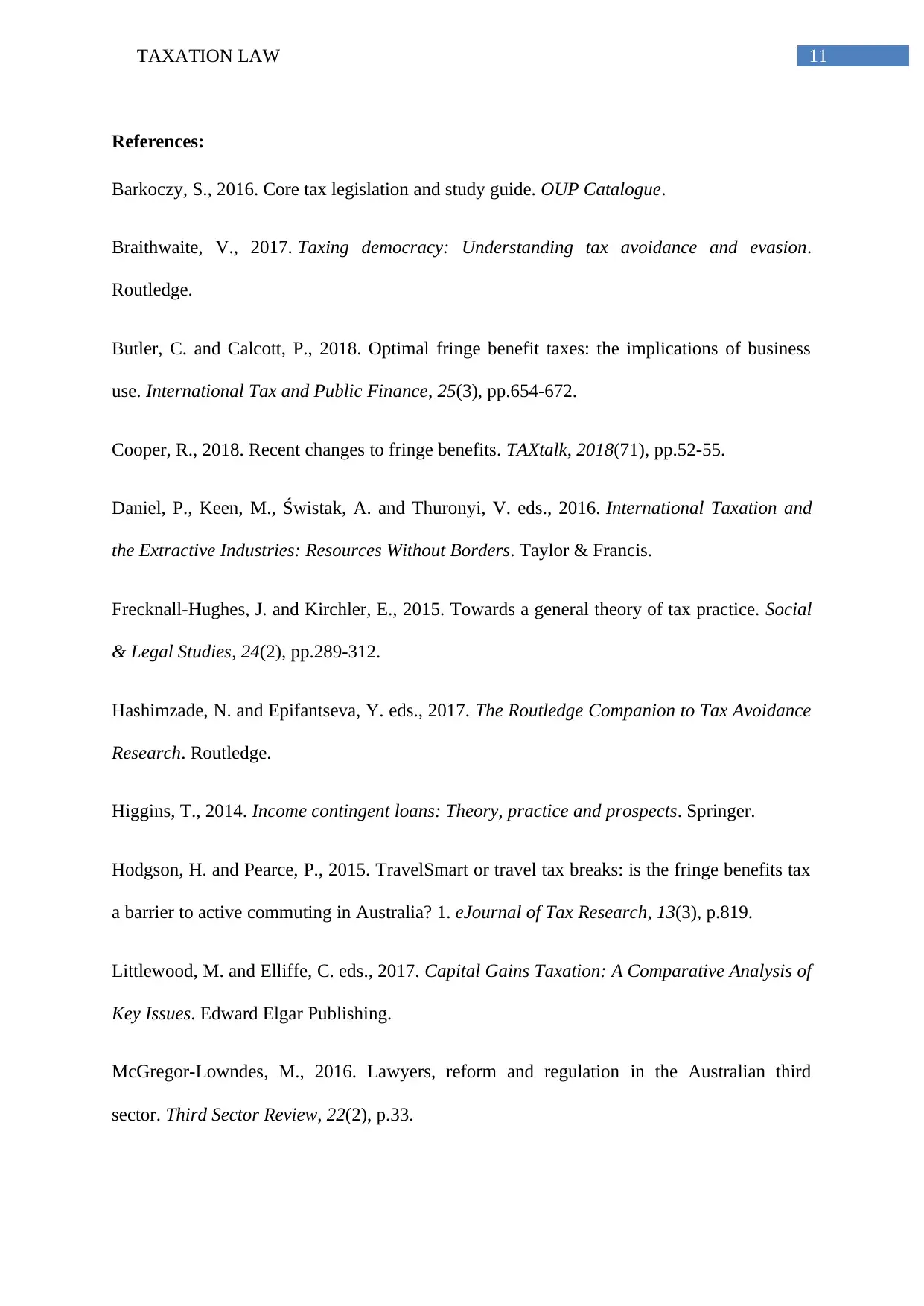
11TAXATION LAW
References:
Barkoczy, S., 2016. Core tax legislation and study guide. OUP Catalogue.
Braithwaite, V., 2017. Taxing democracy: Understanding tax avoidance and evasion.
Routledge.
Butler, C. and Calcott, P., 2018. Optimal fringe benefit taxes: the implications of business
use. International Tax and Public Finance, 25(3), pp.654-672.
Cooper, R., 2018. Recent changes to fringe benefits. TAXtalk, 2018(71), pp.52-55.
Daniel, P., Keen, M., Świstak, A. and Thuronyi, V. eds., 2016. International Taxation and
the Extractive Industries: Resources Without Borders. Taylor & Francis.
Frecknall-Hughes, J. and Kirchler, E., 2015. Towards a general theory of tax practice. Social
& Legal Studies, 24(2), pp.289-312.
Hashimzade, N. and Epifantseva, Y. eds., 2017. The Routledge Companion to Tax Avoidance
Research. Routledge.
Higgins, T., 2014. Income contingent loans: Theory, practice and prospects. Springer.
Hodgson, H. and Pearce, P., 2015. TravelSmart or travel tax breaks: is the fringe benefits tax
a barrier to active commuting in Australia? 1. eJournal of Tax Research, 13(3), p.819.
Littlewood, M. and Elliffe, C. eds., 2017. Capital Gains Taxation: A Comparative Analysis of
Key Issues. Edward Elgar Publishing.
McGregor-Lowndes, M., 2016. Lawyers, reform and regulation in the Australian third
sector. Third Sector Review, 22(2), p.33.
References:
Barkoczy, S., 2016. Core tax legislation and study guide. OUP Catalogue.
Braithwaite, V., 2017. Taxing democracy: Understanding tax avoidance and evasion.
Routledge.
Butler, C. and Calcott, P., 2018. Optimal fringe benefit taxes: the implications of business
use. International Tax and Public Finance, 25(3), pp.654-672.
Cooper, R., 2018. Recent changes to fringe benefits. TAXtalk, 2018(71), pp.52-55.
Daniel, P., Keen, M., Świstak, A. and Thuronyi, V. eds., 2016. International Taxation and
the Extractive Industries: Resources Without Borders. Taylor & Francis.
Frecknall-Hughes, J. and Kirchler, E., 2015. Towards a general theory of tax practice. Social
& Legal Studies, 24(2), pp.289-312.
Hashimzade, N. and Epifantseva, Y. eds., 2017. The Routledge Companion to Tax Avoidance
Research. Routledge.
Higgins, T., 2014. Income contingent loans: Theory, practice and prospects. Springer.
Hodgson, H. and Pearce, P., 2015. TravelSmart or travel tax breaks: is the fringe benefits tax
a barrier to active commuting in Australia? 1. eJournal of Tax Research, 13(3), p.819.
Littlewood, M. and Elliffe, C. eds., 2017. Capital Gains Taxation: A Comparative Analysis of
Key Issues. Edward Elgar Publishing.
McGregor-Lowndes, M., 2016. Lawyers, reform and regulation in the Australian third
sector. Third Sector Review, 22(2), p.33.
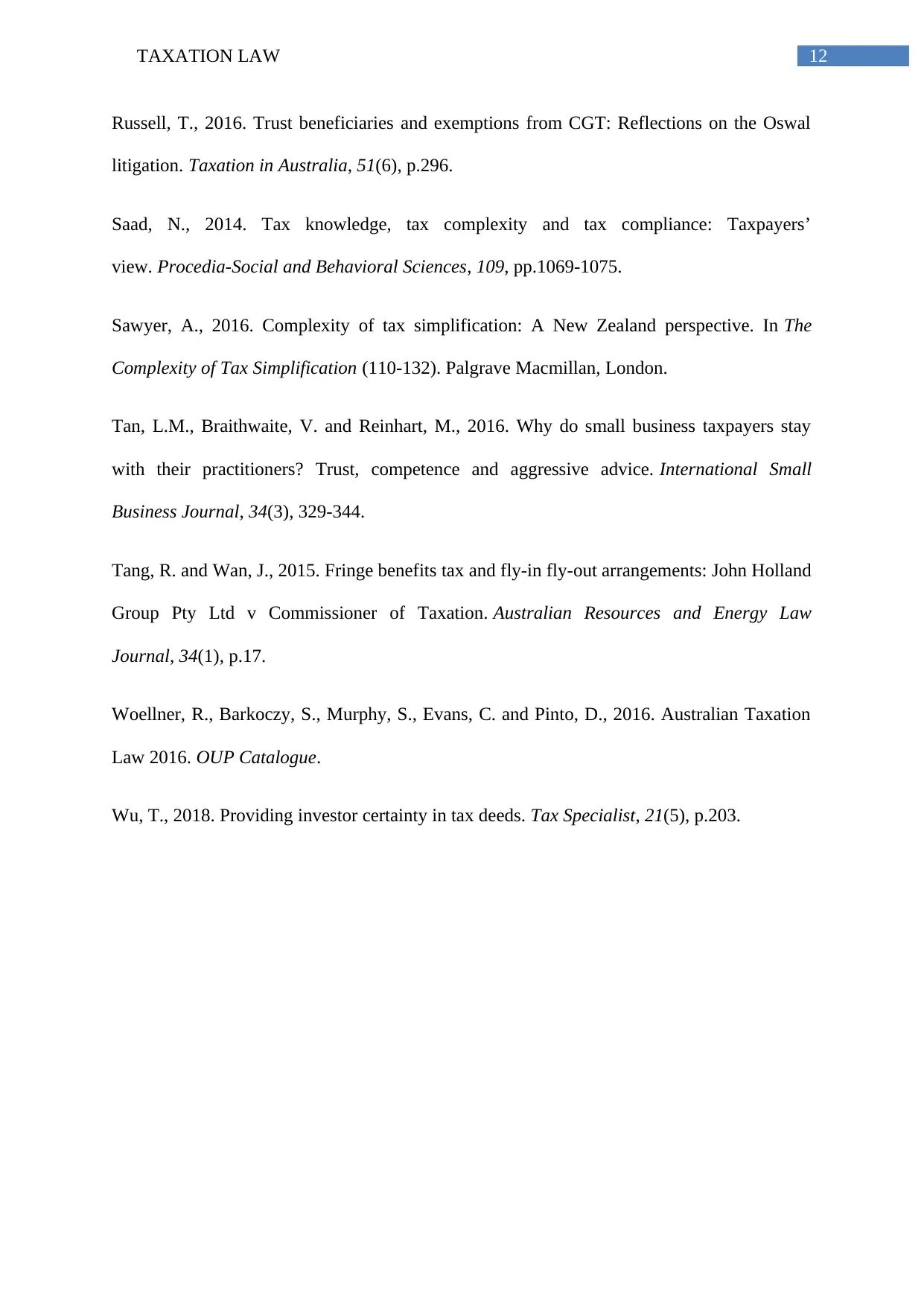
12TAXATION LAW
Russell, T., 2016. Trust beneficiaries and exemptions from CGT: Reflections on the Oswal
litigation. Taxation in Australia, 51(6), p.296.
Saad, N., 2014. Tax knowledge, tax complexity and tax compliance: Taxpayers’
view. Procedia-Social and Behavioral Sciences, 109, pp.1069-1075.
Sawyer, A., 2016. Complexity of tax simplification: A New Zealand perspective. In The
Complexity of Tax Simplification (110-132). Palgrave Macmillan, London.
Tan, L.M., Braithwaite, V. and Reinhart, M., 2016. Why do small business taxpayers stay
with their practitioners? Trust, competence and aggressive advice. International Small
Business Journal, 34(3), 329-344.
Tang, R. and Wan, J., 2015. Fringe benefits tax and fly-in fly-out arrangements: John Holland
Group Pty Ltd v Commissioner of Taxation. Australian Resources and Energy Law
Journal, 34(1), p.17.
Woellner, R., Barkoczy, S., Murphy, S., Evans, C. and Pinto, D., 2016. Australian Taxation
Law 2016. OUP Catalogue.
Wu, T., 2018. Providing investor certainty in tax deeds. Tax Specialist, 21(5), p.203.
Russell, T., 2016. Trust beneficiaries and exemptions from CGT: Reflections on the Oswal
litigation. Taxation in Australia, 51(6), p.296.
Saad, N., 2014. Tax knowledge, tax complexity and tax compliance: Taxpayers’
view. Procedia-Social and Behavioral Sciences, 109, pp.1069-1075.
Sawyer, A., 2016. Complexity of tax simplification: A New Zealand perspective. In The
Complexity of Tax Simplification (110-132). Palgrave Macmillan, London.
Tan, L.M., Braithwaite, V. and Reinhart, M., 2016. Why do small business taxpayers stay
with their practitioners? Trust, competence and aggressive advice. International Small
Business Journal, 34(3), 329-344.
Tang, R. and Wan, J., 2015. Fringe benefits tax and fly-in fly-out arrangements: John Holland
Group Pty Ltd v Commissioner of Taxation. Australian Resources and Energy Law
Journal, 34(1), p.17.
Woellner, R., Barkoczy, S., Murphy, S., Evans, C. and Pinto, D., 2016. Australian Taxation
Law 2016. OUP Catalogue.
Wu, T., 2018. Providing investor certainty in tax deeds. Tax Specialist, 21(5), p.203.
1 out of 13
![[object Object]](/_next/static/media/star-bottom.7253800d.svg)


